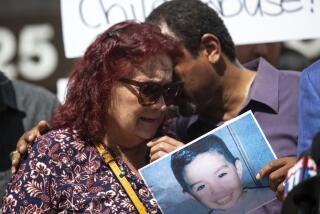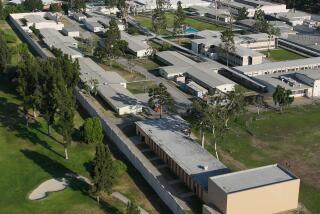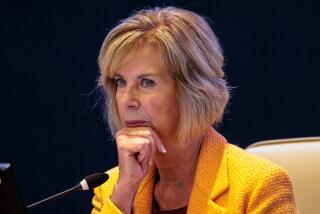Let the L.A. County child welfare commission do its work
A special commission to review Los Angeles County’s child protection system convened for the first time on Aug. 1 — and then promptly vanished from the headlines. Whatever happened to the Blue Ribbon Commission on Child Protection?
It’s a front-burner question because the Board of Supervisors on Tuesday is considering a motion to extend the panel’s life, giving it until April 18, 2014, to file its final report. If the motion is rejected, the commission sunsets at the end of this year.
So if the panel was created in the wake of the high-profile death in May of 8-year-old Gabriel Fernandez of Palmdale, and if its public proceedings have been fairly quiet and attracted virtually no media coverage, and if it took the commission far too long to hire staff, and if for months it was virtually impossible for the public to find agendas, minutes, recordings and reports (although they were all available to anyone who spent enough time poking around the county’s website), and if the Board of Supervisors was bitterly divided on creating the panel in the first place, with opponents noting that the Department of Children and Family Services already had a new director overseeing a new reform plan and that there were upward of 80 previous reports from panels, experts and others gathering dust on various county shelves — should the commission get an additional three and a half months to complete its work?
Emphatically, yes.
The commission is doing exactly what it is supposed to do: It’s examining the entire network of agencies and institutions, public and private, that deal with abuse and neglect of children in Los Angeles County, to determine the degree to which they actually solve real problems and the degree to which they instead trip over one another’s feet. It must next take what it has learned and craft a set of critiques and recommendations that transcend politics and power bases and can lead directly to improved results for children at risk.
That is a long and complex job, requiring hours of testimony from dozens of professionals, law enforcement leaders, judges, labor representatives, contractors and others with a stake in child welfare. A six-month tenure would have been too ambitious for such a task under any circumstances, but the commission didn’t get underway until August, and it needed several meetings and rounds of discussions before taking testimony.
Commission members have to bear at least some blame for their slow start. They didn’t have an executive director or other staff in place until mid-October, halfway through their tenure. But that’s at least equally the responsibility of the county, which ran the hiring process and is providing the funding; and in any event, the panel is fully staffed now.
Despite the many previous audits, reviews and reports, there really hasn’t been anything quite like this effort. Previous efforts confined themselves to examining the Department of Children and Family Services, or focused on the county’s legal liability or some other particular aspect of the child welfare system.
The Blue Ribbon Commission on Child Protection does something entirely different. Its effort was never intended to be either an inquest into Gabriel Fernandez’s death or a dissection of the department, although there were plenty of critics demanding just such a thing. The commission’s task is to outline why, despite all of those previous reports and reform efforts, avoidable child deaths keep happening.
The commissioners are finding their answers, to judge from the testimony of witnesses and the discussions among commissioners so far, chiefly in two places: in the bureaucratic silos that keep teachers, doctors, nurses, police officers and others from reporting warning signs of child abuse or neglect (or that keep any such reports from getting action by social workers); and the political push and pull on the Board of Supervisors that all too often results in at least the impression, and often the reality, that the rules that social workers must follow are in flux and that the directions under which department leaders operate can change at any moment.
That latter point provides two more reasons to keep the panel working. First, the chief argument of Supervisors Zev Yaroslavsky and Don Knabe in opposition to the motion creating the commission was that the buck stops with the board, the board made a management change at the Department of Children and Family Services and is monitoring progress, and it is the board, and not some outside commissions, that should oversee and correct the department.
But if the child welfare system extends beyond the department and even county government, as it does, it requires a point of view from outside the county; and if the barriers to an effective system include the Board of Supervisors itself, as they do, the board cannot be counted on to provide its own critique.
The second reason is admittedly circumstantial but in the end perhaps most important: County government next year begins an overhaul at the top, as Yaroslavsky and Supervisor Gloria Molina are termed out and Sheriff Lee Baca faces reelection. Those elections take place June 3.
And though Molina and Yaroslavsky no doubt want to get the county house in order on their own watch, the fact is that the child welfare system has been in turmoil for years and is unlikely to be completely tidied up in the next few months. The deliberations and recommendations of the Blue Ribbon Commission on Child Protection should be part of the debate among the people who would be vying to implement them: the candidates for office. A December report from the commission is more likely to disappear into the stack of prior dusty audits and reviews. An April report would, and should, make the county child welfare system the centerpiece of the conversation between candidates and voters.
ALSO:
Iran’s Rouhani: He’s no Gorbachev
So much data-gathering, so little doctoring
More to Read
A cure for the common opinion
Get thought-provoking perspectives with our weekly newsletter.
You may occasionally receive promotional content from the Los Angeles Times.







